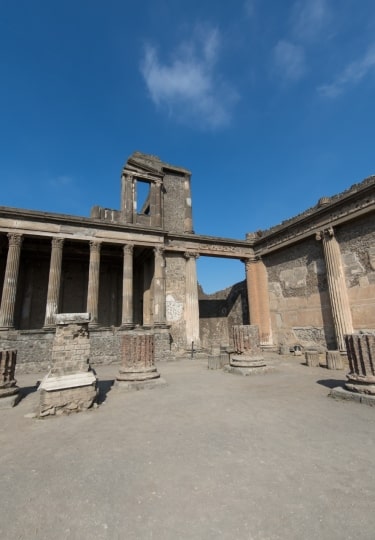Some of the best European attractions are its natural wonders, from the fjords of Norway to its Mediterranean beaches. Then there are the beautiful vineyards of Portugal’s Douro region and the lakes of Scotland.
Added to those are Europe’s historic places, from Rome’s Colosseum to England’s even older Stonehenge. Barcelona’s century-old Sagrada Familia or Pisa’s 1,000-year-old Leaning Tower are almost modern compared to those.
For real modernity, you can visit Bilbao’s Guggenheim Museum or the City of Arts & Sciences in Valencia. All this makes for a wide choice of sights that will take a lifetime to visit.
Sagrada Família, Barcelona, Spain
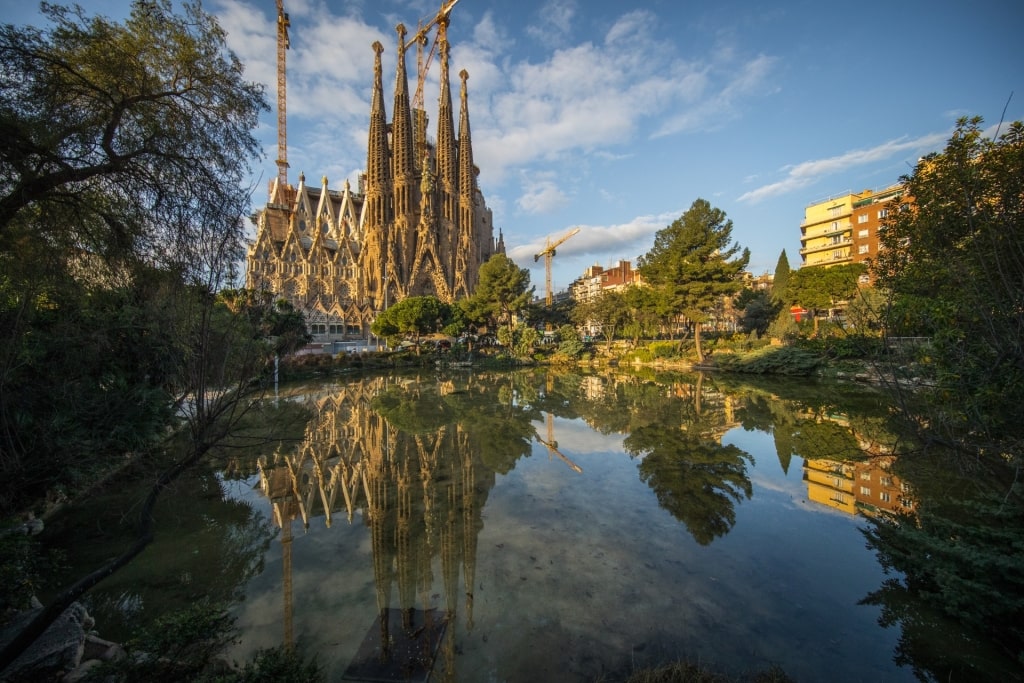
Sagrada Família in Barcelona, Spain
Among all the best European attractions, the Sagrada Família in Barcelona must be among the most famous. It has taken since 1882 to achieve its present, still unfinished but remarkable form.
Designed by Catalan architect Antoni Gaudí, this Spanish landmark is a unique blend of Gothic and Art Nouveau styles. When finished, hopefully in 2026, it will be the world’s tallest church.
The three grand facades and soaring interior were inspired by nature, with columns that bring giant trees to mind. Take a guided tour to fully understand Gaudí’s vision and the Christian symbolism behind every detail.
Pulpit Rock, Stavanger, Norway
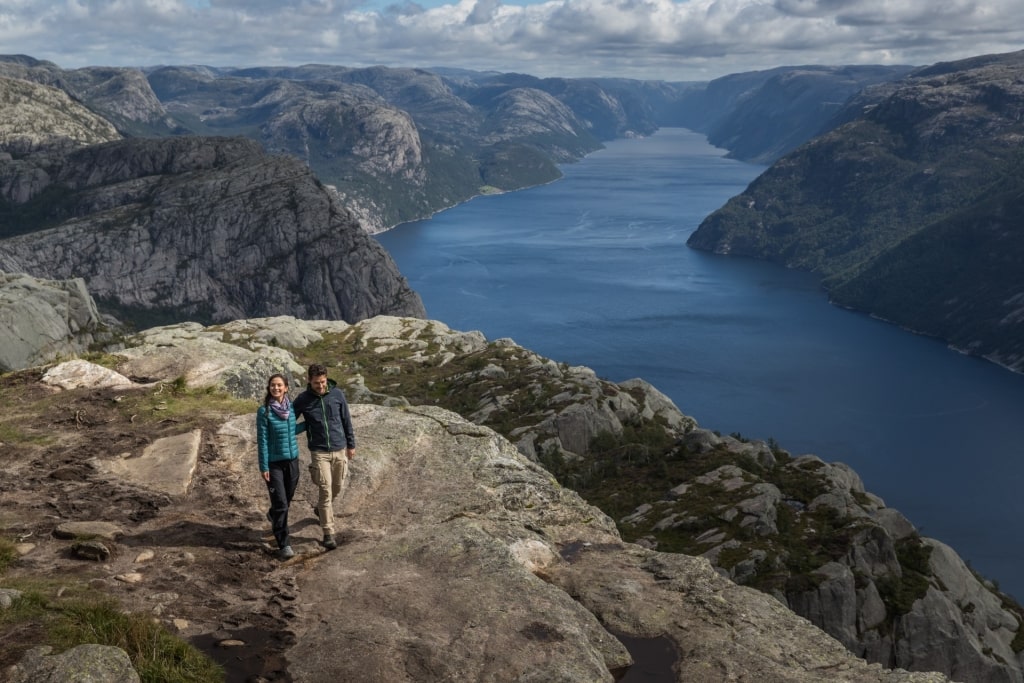
Pulpit Rock in Stavanger, Norway
Tom Cruise has dangled from its edge and countless selfies from on top of it have adorned social media. The vertiginous view from soaring Pulpit Rock has surely now been immortalized worldwide.
Reached by a 2.5-mile each-way hike, Preikestolen—as it’s known in Norwegian—stands 1,982 feet high. It towers over Lysefjord in southwestern Norway, 15 miles from Stavanger.
The flat top, some 80 ft by 80 ft, is a large viewing platform giving photographers wonderful images of the landscape that Norway is known for. However, the cliff edge is completely unprotected, so stay well away from that sheer drop.
Loch Ness, Scotland
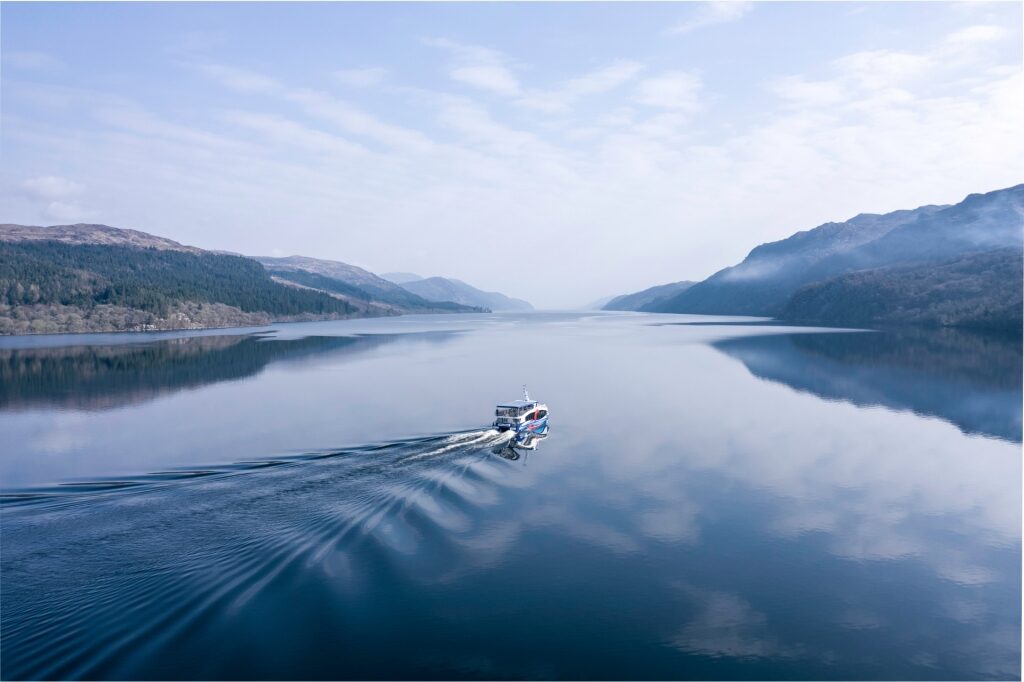
Loch Ness, Scotland
World famous for its elusive “Loch Ness Monster”, Loch Ness runs for 23 miles southwest from Inverness. It is part of a canal system that links the east and west coasts of Scotland.
The loch should be seen from a boat, where the wake patterns on its calm, dark waters are mesmerizing. You can easily see where stories of strange nautical creatures come from.
Scotland is also known for its castles and the ruins of the 13th-century Urquhart Castle present a prominent and romantic lakeshore image here, overlooking the brooding landscape. Visitors can also enjoy picturesque villages such as Drumnadrochit and Fort Augustus along the shoreline.
Guggenheim Museum, Bilbao, Spain
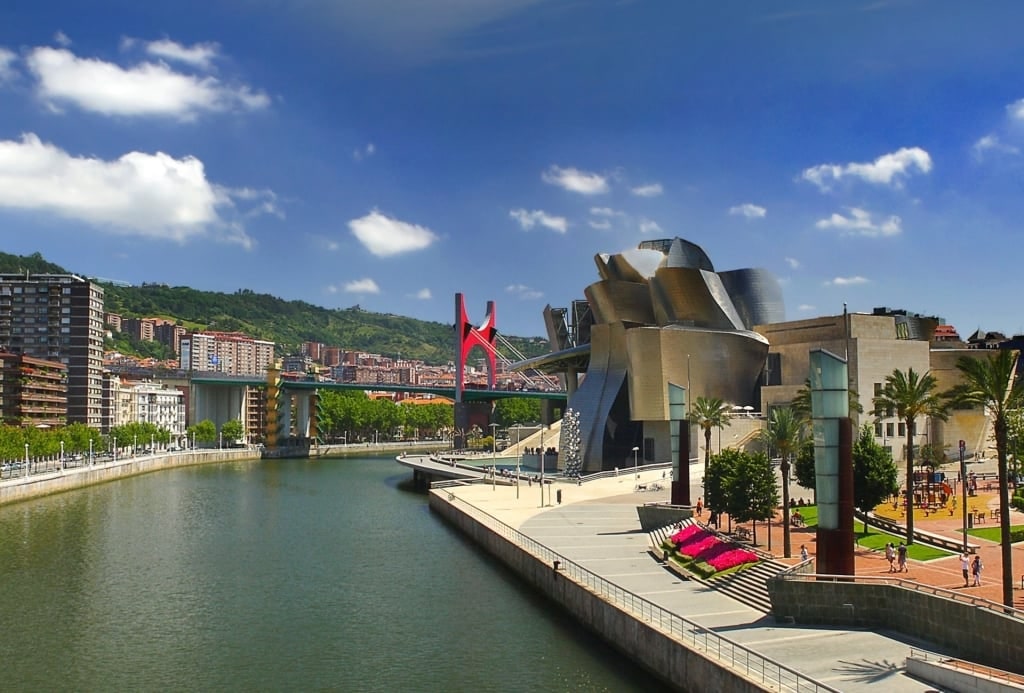
Guggenheim Museum in Bilbao, Spain
The Guggenheim Museum in Bilbao has become a landmark and symbol of the city. Designed by Canadian-American architect Frank Gehry, it’s a masterpiece of contemporary architecture.
Opened in 1997, this unique building features curved, titanium-clad forms that lend it a sculptural appearance. The museum has helped transform Bilbao’s reputation from a fading industrial city to a cultural destination.
The museum houses modern and contemporary art by both Spanish and international artists. Highlights include Jeff Koons’ Puppy sculpture and Untitled by Mark Rothko.
Geirangerfjord, Geiranger, Norway
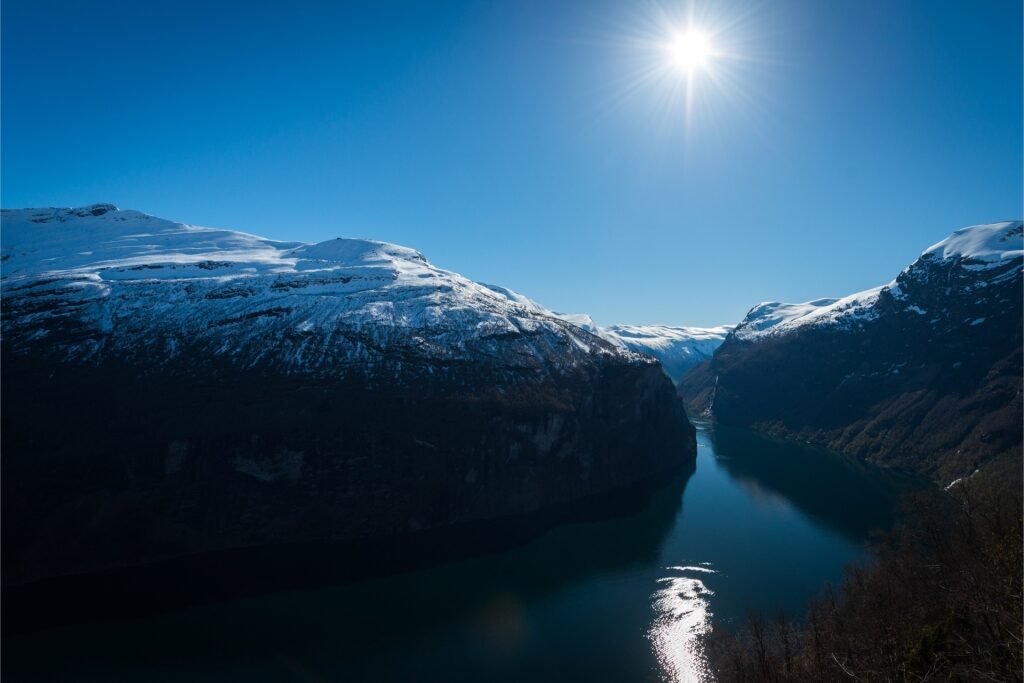
Geirangerfjord in Geiranger, Norway
Geirangerfjord, 62 miles from the coastal town of Ålesund, is among the most dramatic of Norway’s many beautiful fjords. At almost ten miles in length, it has steep cliffs, deep waters, and waterfalls with names such as “The Bridal Veil”.
Visitors can explore the fjord on cruises, in kayaks, or by hiking its rich landscape. Breathtaking views reveal themselves around every bend until you reach the village of Geiranger at its head.
Here, you’ll find the Norwegian Fjord Center, as well as restaurants, shops, and a quaint wooden church. It is also a base for hiking, visiting mountain farms, or discovering more panoramic viewpoints.
Amsterdam Canal Ring, Netherlands
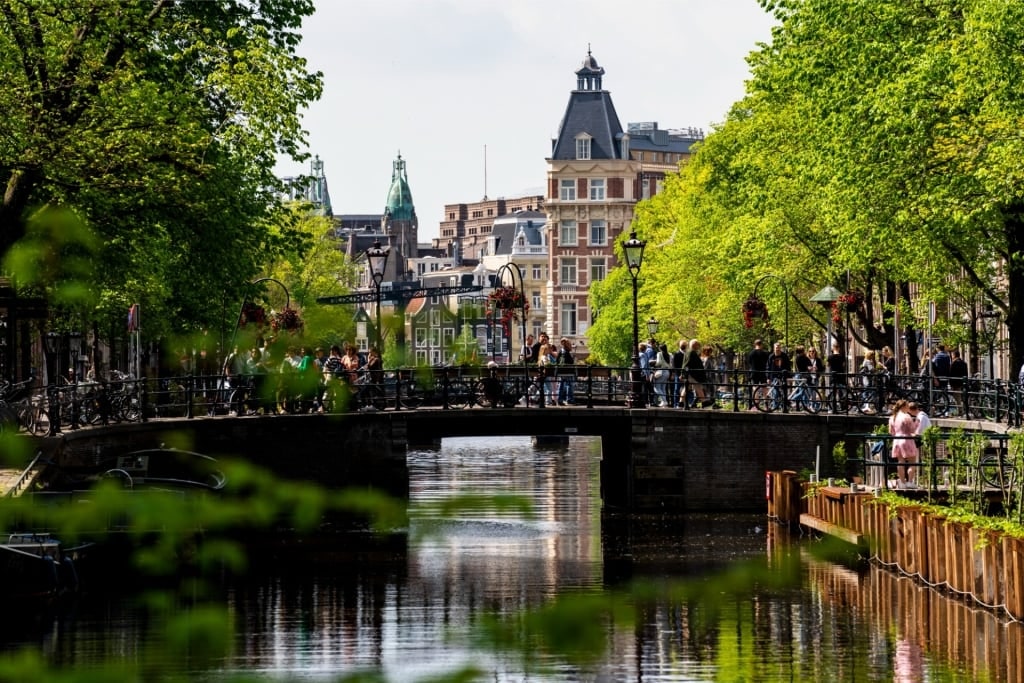
Amsterdam Canal Ring, Netherlands
The Canal Ring forms a web of waterways around the heart of Amsterdam’s historic center. Developed during the 17th century, it has four main concentric half-circles: Singel, Herengracht, Keizersgracht, and Prinsengracht.
The Amsterdam canals were built in the Dutch Golden Age for water management, defense, and the transport of goods. They are lined with the narrow, gabled houses that once served as both homes and warehouses for merchants.
Hundreds of picturesque bridges straddle the canals and houseboats line their banks. You’ll also find numerous shops, art museums, galleries, and restaurants.
Cíes Islands, Spain
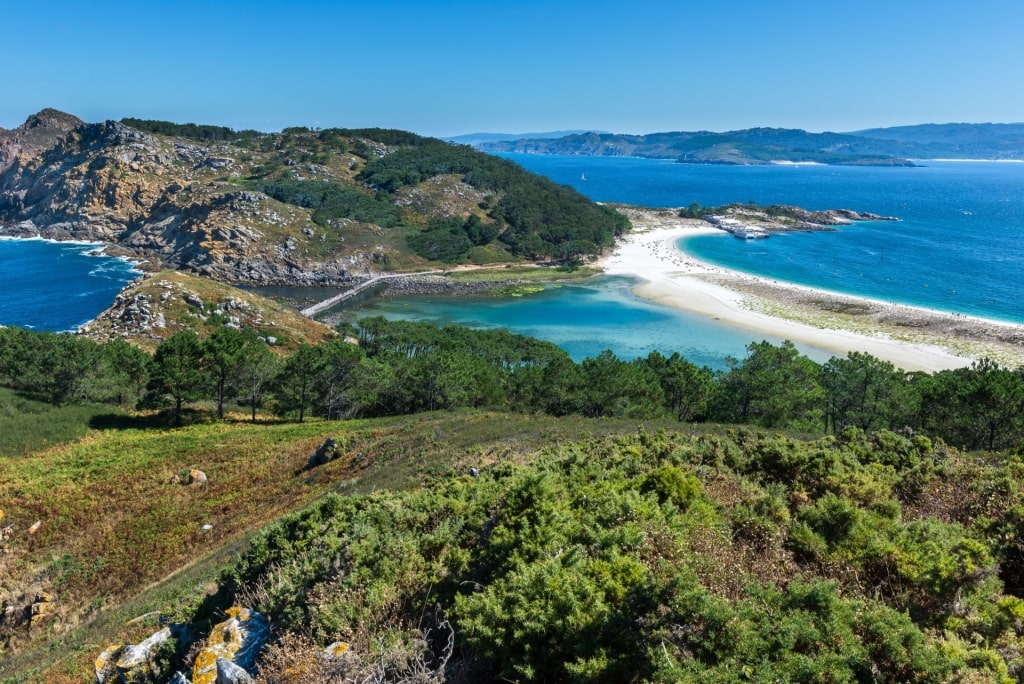
Cíes Islands, Spain
The Cíes Islands stand in the Vigo Estuary off the coast of Galicia, in northwestern Spain. They are made up of three main islands, two of which are connected by Rodas Beach.
Rodas is one of the world’s best beaches and is now protected with the islands inside a Natural Park. Rugged cliffs, dense forests, and several idyllic beaches make Cies a paradise for hikers, divers, kayakers, and birdwatchers.
The uninhabited islands are connected by a regular ferry service from Vigo. Visitor numbers are restricted to preserve the peace and environment of this perfect piece of paradise.
Nyhavn, Copenhagen, Denmark
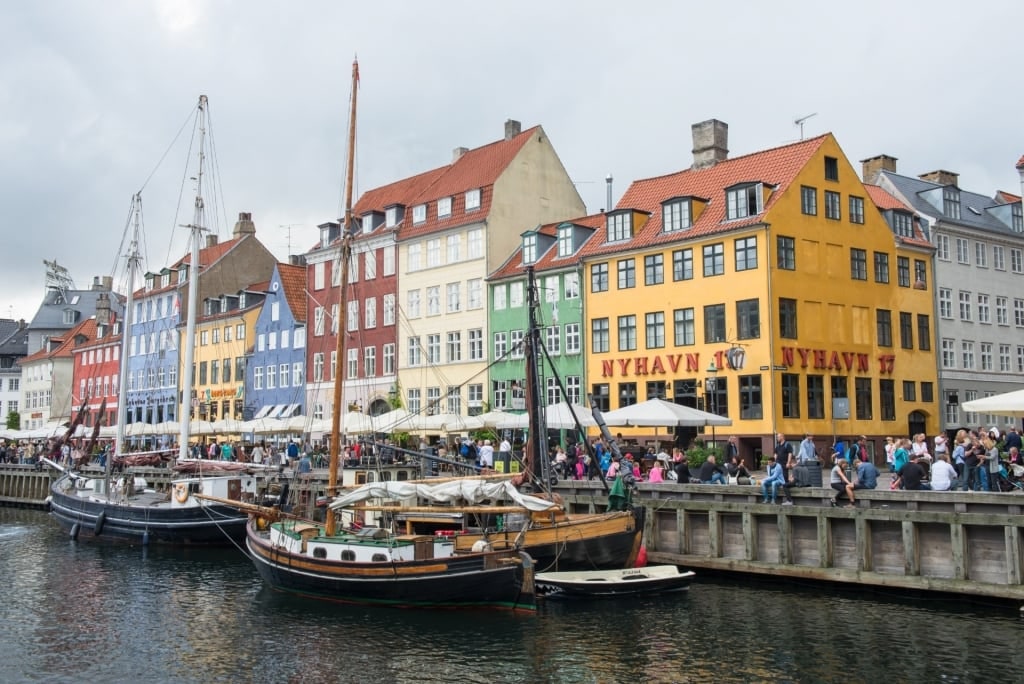
Nyhavn in Copenhagen, Denmark
Nyhavn, the “New Harbor”, was dug out in the 1670s to connect Copenhagen’s inner city to the sea. This district is now known for its colorful 17th and 18th-century townhouses.
The original Copenhagen port is still home to many picturesque historical sailing boats. Former taverns and seedy sailor hostels are now dockside restaurants, cafés, and bars.
Visiting Nyhavn is one of the best things to do in Copenhagen for both locals and visitors to enjoy its vibrant social life. It’s also a popular starting point for walking or biking tours of the city.
Bryggen, Bergen, Norway
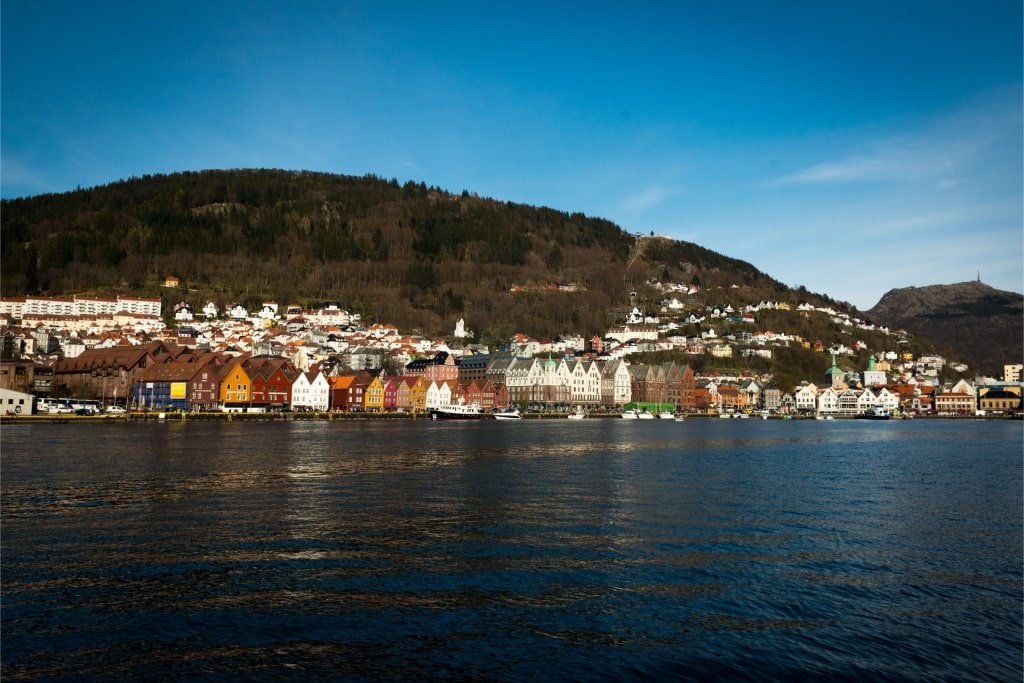
Bryggen in Bergen, Norway
Bryggen is the historic district of Bergen in Norway, built around an atmospheric harbor. Colorful, traditional tall wooden buildings face the dockside to create an evocative picture of the past.
Bryggen was a key trading port of the Hanseatic League, with a wealth built on dried cod. Although burned down several times in history, it has always been faithfully restored.
There are several museums to explain that long and fascinating history. However, for many visitors, the best things to do in Bergen are found in the craft shops, art galleries, restaurants, and bars of Bryggen.
Sete Cidades, Azores, Portugal
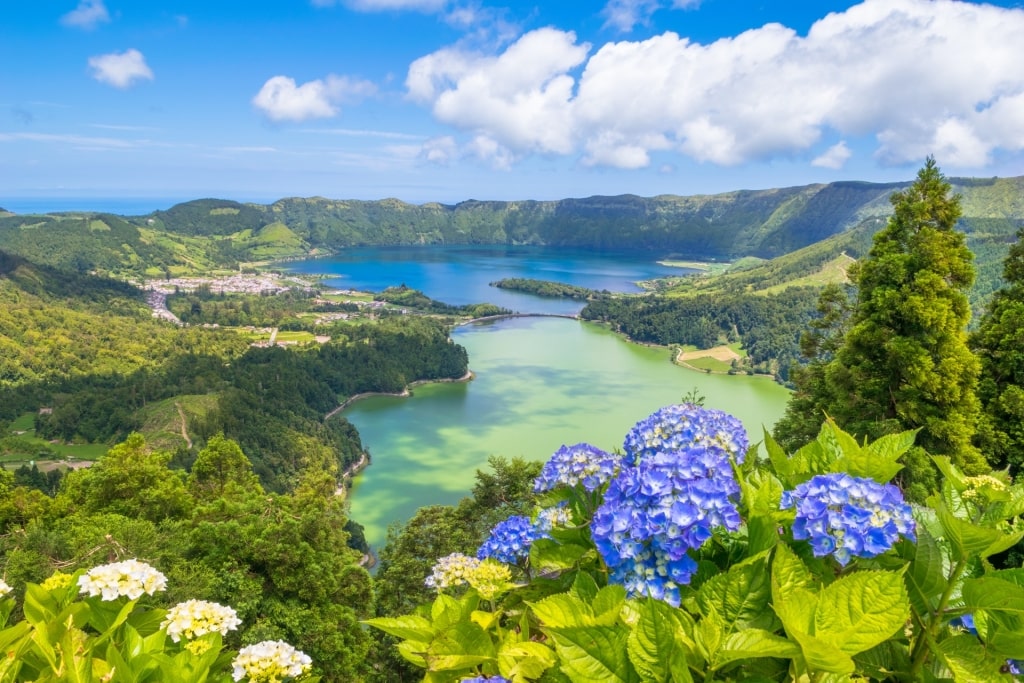
Sete Cidades in the Azores, Portugal
Sete Cidades, or “Seven Cities” takes its name from a legend that seven cities sank to form two lakes. The blue Lagoa Azul and green Lagoa Verde fill a crater on São Miguel Island, the largest of the Azores.
Before it became one of the most beautiful lakes in the world, the crater was formed by a massive volcanic eruption about 22,000 years ago. You have a sense of its scale from the panoramic viewpoint at Vista do Rei.
A small village, also called Sete Cidades, stands within the crater. It is a convenient base for anyone wishing to hike, bike, kayak, or paddleboard in the area.
Suomenlinna Fortress, Helsinki, Finland
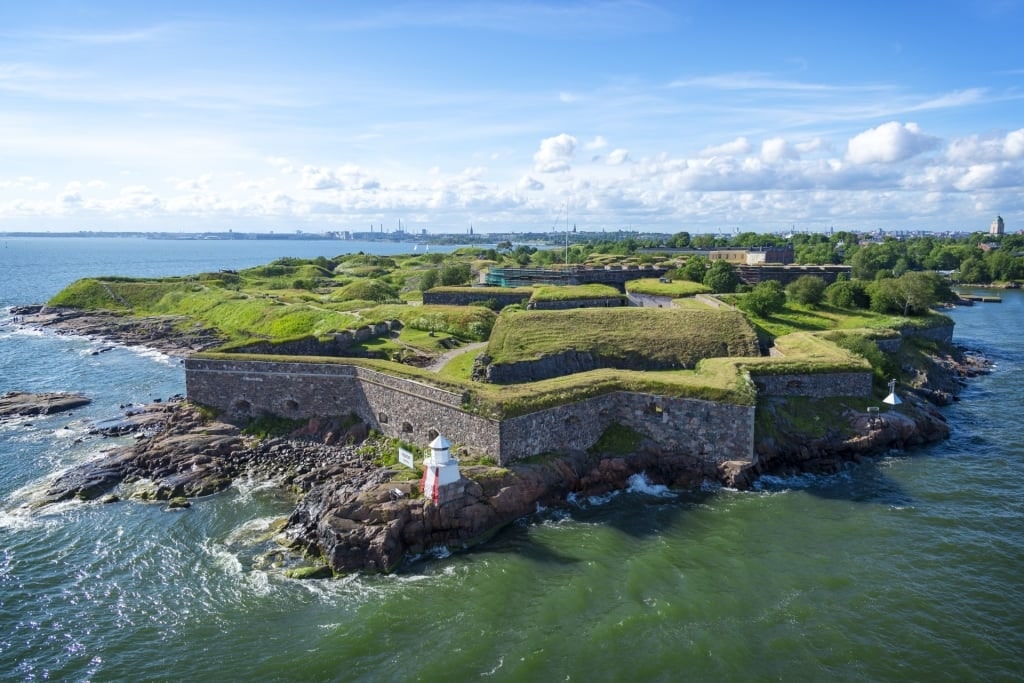
Suomenlinna Fortress in Helsinki, Finland
Suomenlinna Fortress was built during the 18th century as a base for the Swedish Navy. Six islands were heavily fortified during a time when Finland was part of the Swedish Kingdom.
The fortress is an important example of the handsome military architecture of its era, designed to protect against Russian expansionism. Two interesting museums showcase its history, with a Toy Museum being a bonus for the child within us all.
Reached by a short ferry ride from the Market Square of Helsinki, Suomenlinna is now a popular recreational area. You’ll also find walking trails, swimming, and ice skating in winter.
Read: Best Things to Do in Helsinki
City of Arts and Sciences, Valencia, Spain

City of Arts and Sciences in Valencia, Spain
The City of Arts and Sciences, or Ciudad de las Artes y las Ciencias, is an impressive modern development in Valencia, Spain. Designed primarily by Valencian architect Santiago Calatrava, it’s one of the largest scientific and cultural complexes in Europe.
Major buildings include Hemisfèric, an IMAX cinema, and planetarium; and Umbracle, a walkway landscaped with native plant species. Oceanogràfic, Europe’s largest aquarium and Museu de las Ciències Príncipe Felipe, an interactive science museum, are also significant structures.
The futuristic architecture is an avant-garde backdrop to the Àgora, a covered plaza used for public events. Visiting is now one of the best things to do in Valencia and is a symbol of modern Spain.
Belém Tower, Lisbon, Portugal
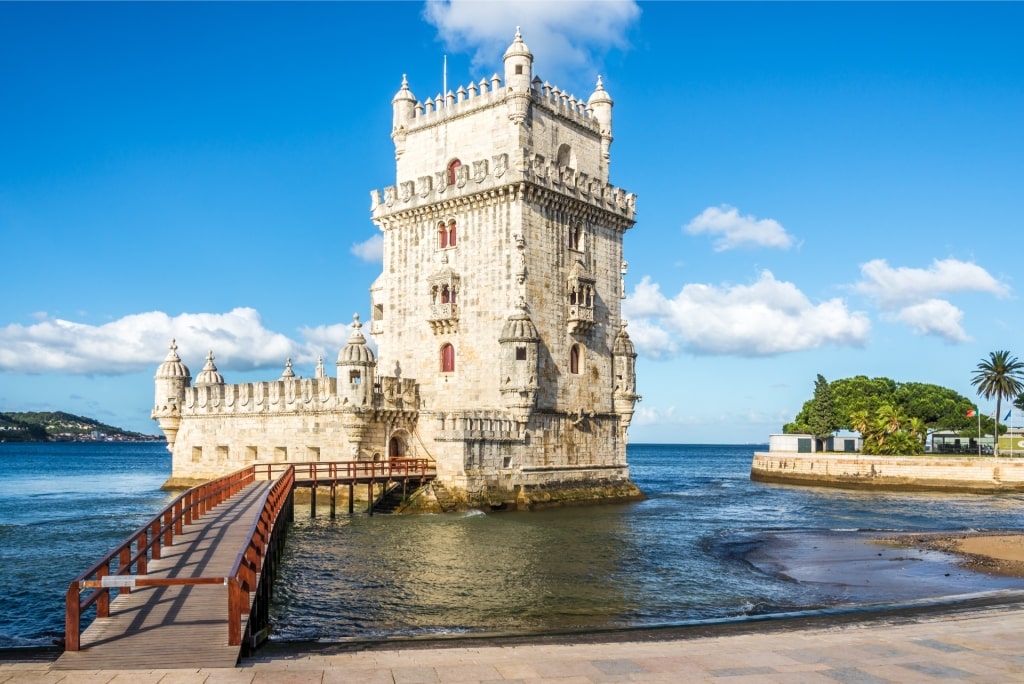
Belém Tower in Lisbon, Portugal
Belém Tower, properly known as the Tower of St Vincent, is an iconic sight on the northern bank of Tagus River in Lisbon. The 16th-century fortification was originally part of a defense system guarding the river mouth.
Incorporating many maritime elements into its design, it’s a prime example of Portuguese late Gothic architectural style. Now one of Portugal’s most visited places, it symbolizes the country’s Age of Discoveries.
The six-sided tower has four floors and views from the top of the Tagus and the city. Along with the nearby Jerónimos Monastery, it forms a historic UNESCO World Heritage Site.
Acropolis of Athens, Greece
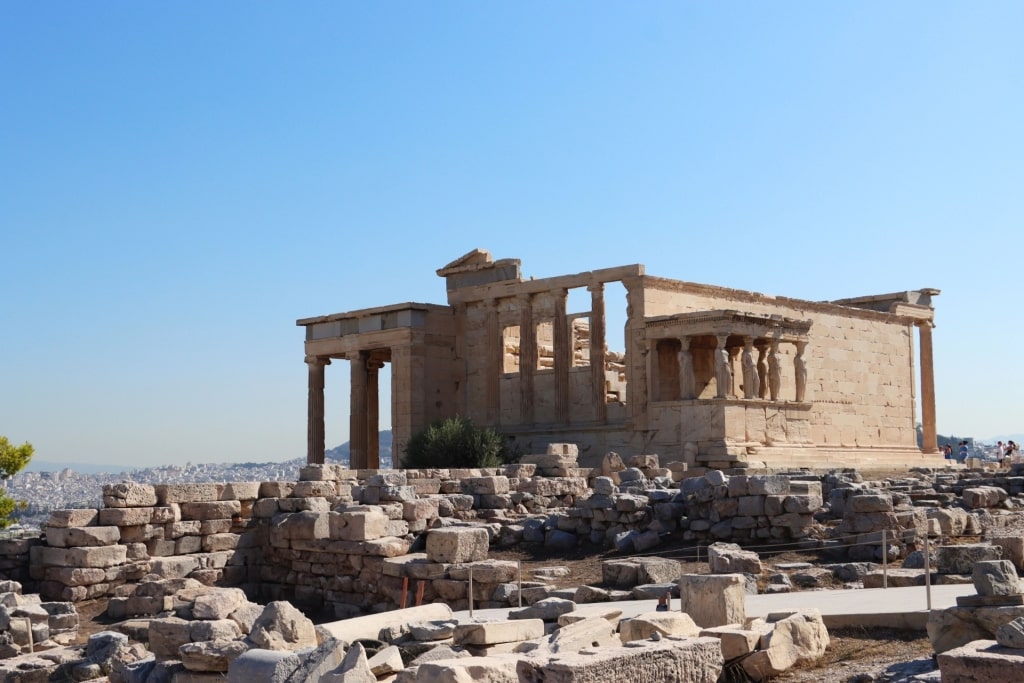
Acropolis of Athens, Greece
One of the most recognizable ancient sites in the world and one of the finest tourist attractions in Europe, the Acropolis stands on a hill overlooking Athens. It’s a symbol of classical Greek culture and the birthplace of democracy.
The central part is the Parthenon, a popular Greek landmark built in the 5th century BC to mark victory in the Greco-Persian Wars. The Erechtheion, known for its Porch of the Caryatids, was a temple originally dedicated to Athena, the goddess of the city.
At the foot of the Acropolis is a modern museum, opened in 2009. Start here to better understand the complex, before taking the funicular to see its wonders closer up.
Hagia Sophia, Istanbul, Turkey
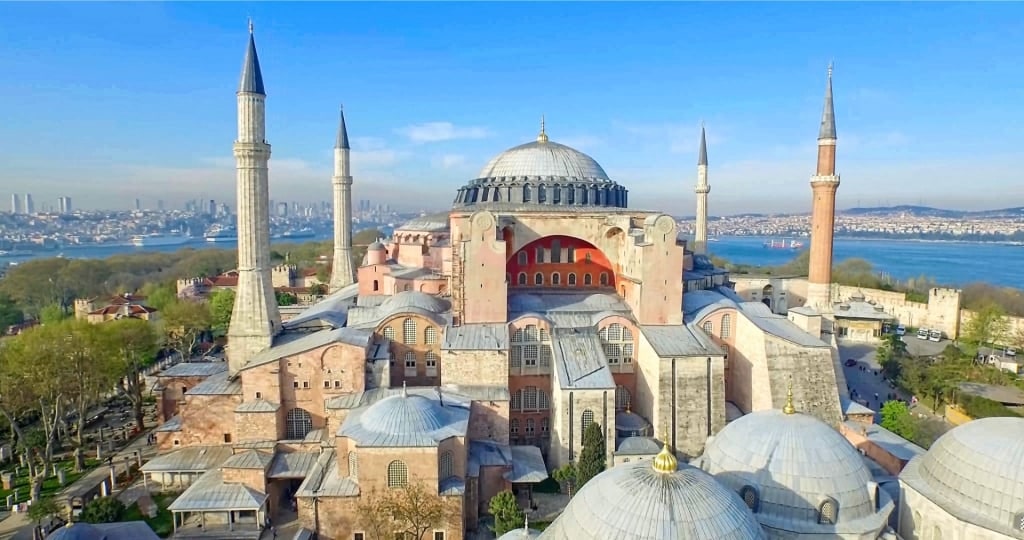
Hagia Sophia in Istanbul, Turkey
Hagia Sophia in Istanbul is one of the most phenomenal tourist attractions in Europe. This architectural marvel has influenced Islamic architecture around the world. In turn, the roots of Roman architecture in its Byzantine style is obvious.
Built as a Christian cathedral around 537 AD, it was the world’s largest church for nearly 1,000 years. The massive dome, 102 ft in diameter and 180 ft high, was the engineering marvel of its time.
The wonders continue inside, with Byzantine mosaics, marble pillars, and Islamic calligraphy that make it one of the best places to visit in Istanbul. Now a mosque, it’s open to visitors outside of prayer times.
Seville Cathedral, Seville, Spain
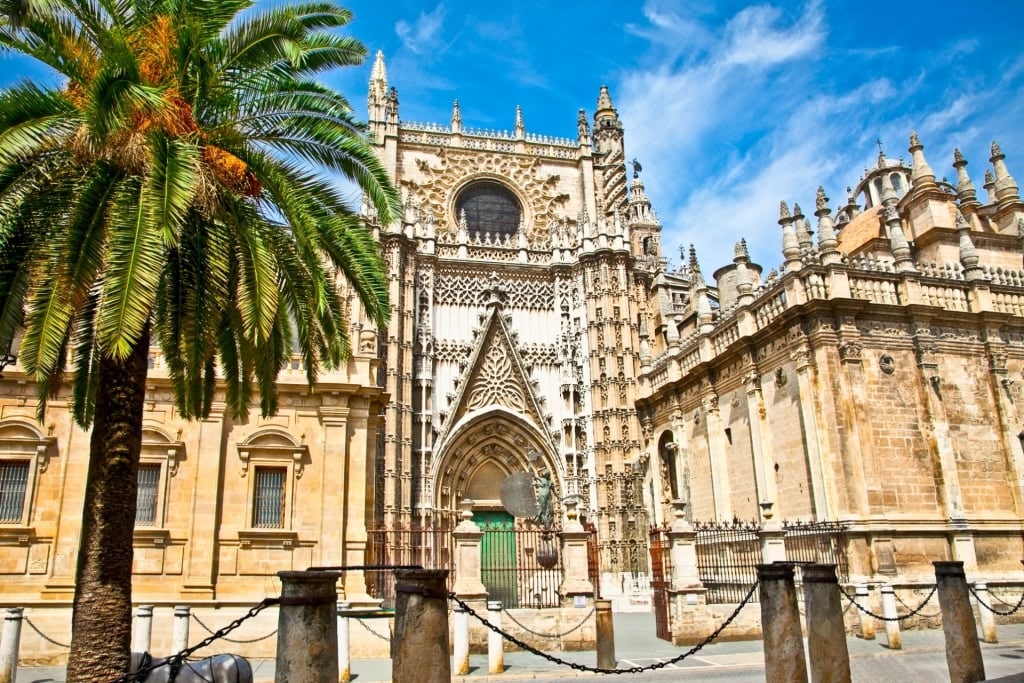
Seville Cathedral in Seville, Spain
Seville Cathedral, the world’s largest Gothic cathedral, dates to 1528, having taken 120 years to build. It holds what are said to be the remains of Christopher Columbus.
Its altarpiece is the largest in the world, the central nave rising to 140 feet. The art within it includes work by Spanish masters Murillo and Goya.
The cathedral’s bell tower, La Giralda, was originally the minaret of a mosque it replaced. Climb the ramp to the top to enjoy great views of the rest of Seville.
Leaning Tower of Pisa, Italy
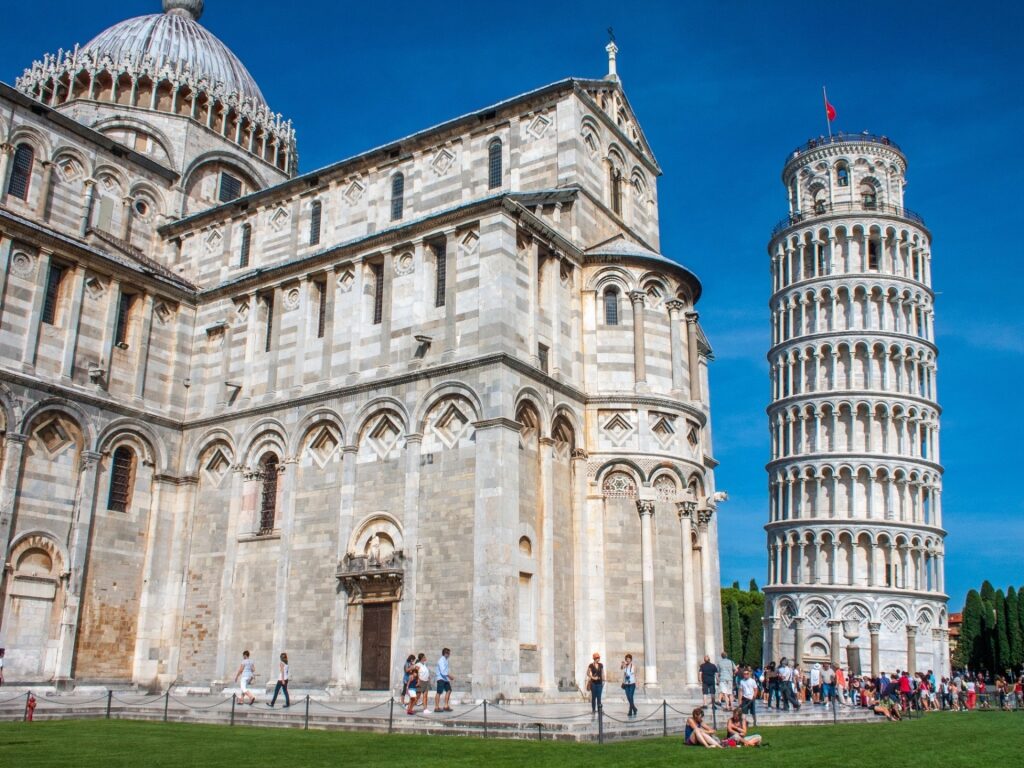
Leaning Tower of Pisa, Italy
There are few more famous sights tourist attractions in Europe than the Leaning Tower of Pisa in Italy. This bell tower, belonging to the city’s Cathedral, Duomo Pisa, was built in 1173.
Problems due to soft ground became immediately apparent and it took 200 years to finish. One of the best places to visit in Italy with kids, the 184-foot-tall white marble tower now leans at close to four degrees.
Climb the 297 steps to the top for views of the Duomo and its plaza. Then pose for yet another photo in front of this Italian wonder.
Gullfoss, Iceland
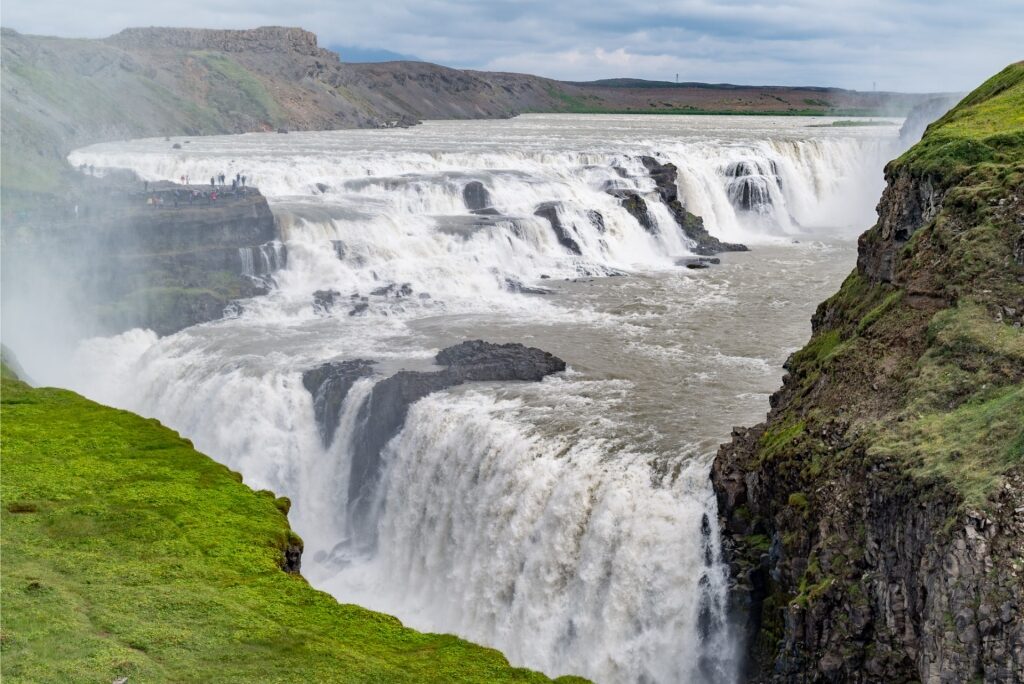
Gullfoss, Iceland
Gullfoss—“Golden Falls” in Icelandic—is the most famous of Iceland’s many beautiful waterfalls. It stands about 75 miles east of Reykjavík, on the “Golden Circle” route, one of the best European attractions for those who love a combination of history and natural beauty.
The falls are fed by the Hvítá River with glacial meltwater from Langjökull. They descend in two stages for a total drop of 100 feet, creating one of Europe’s most powerful waterfalls.
On sunny days, a rainbow forms in the mist raised by the plunging water. Several platforms allow visitors safe access to different viewpoints.
Grand Canal, Venice, Italy
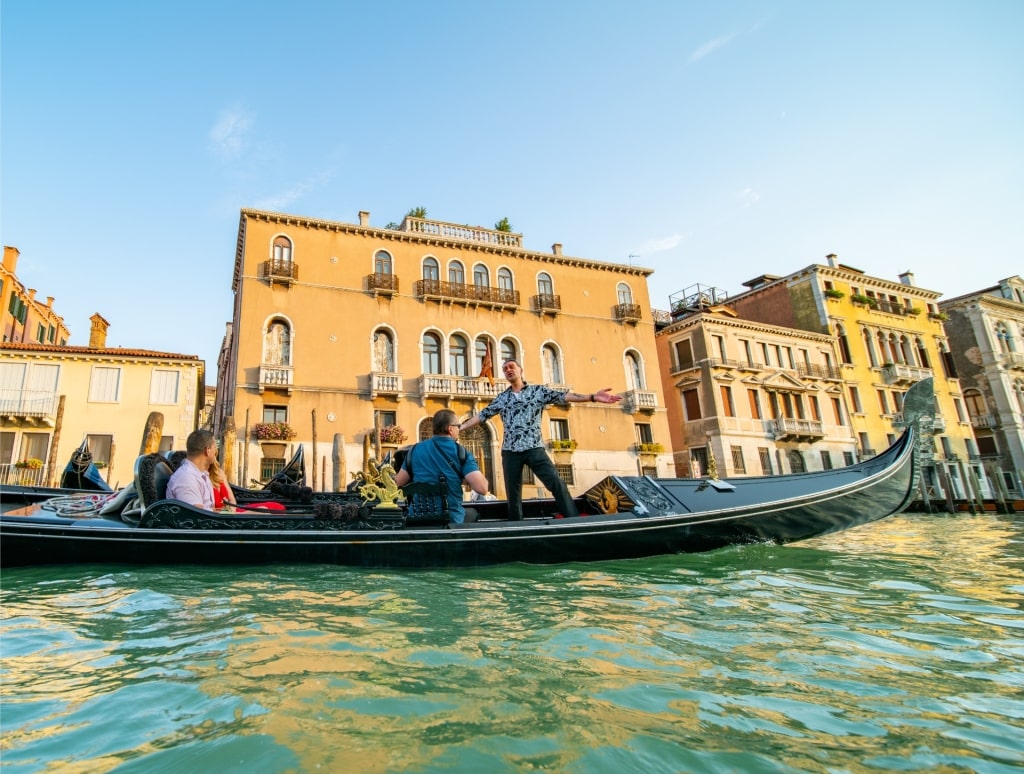
Grand Canal in Venice, Italy
The Grand Canal is Venice’s main waterway and divides the city with a distinctive S-shape. It’s the main thoroughfare, busy with boats of all sizes by day and by night. Featured in countless works of art, literature, and film, the Grand Canal has come to symbolize Venice itself. It is a unique blend of history, function, and beauty.
Many would consider Venice one of the most romantic cities in Europe and if you’re being propelled along the Grand Canal in a gondola, you’ll see why. Several of Venice’s grandest palaces line the canal, showcasing Byzantine, Gothic, and Baroque architectural styles. Four bridges cross it, including the famous 16th-century Rialto Bridge.
Blue Lagoon, Iceland

Blue Lagoon, Iceland
The Blue Lagoon is a very photogenic geothermal spa, some 30 miles from Iceland’s capital of Reykjavík. The distinctive color of its milky-blue water is the result of a high silica content reflecting sunlight.
The lagoon’s water, originating from a geothermal plant, is consistently between 98-102°F, year-round. It is thought to be particularly good for treating skin conditions.
Facilities at the spa include saunas, steam rooms, and a waterfall. There are various treatments available, including massages and an on-site restaurant.
Poetto Beach, Sardinia, Italy

Poetto Beach in Sardinia, Italy
Poetto Beach fills five miles of southern Sardinia’s coastline, just outside Cagliari. Known for its fine white sand and clear turquoise waters, it’s an integral part of the city’s social life.
This Sardinian beach is perfect for sunbathing and ball games and has numerous beach clubs, restaurants, and bars. Its long promenade is busy with walkers and cyclists, while the water is dotted with swimmers and kitesurfers.
Kiosks on the beach will rent you a sunshade, chair, or sun bed. Nearby is Molentargius-Saline Regional Park, home to plenty of birdlife including colorful flamingos.
Arctic Cathedral, Tromso, Norway
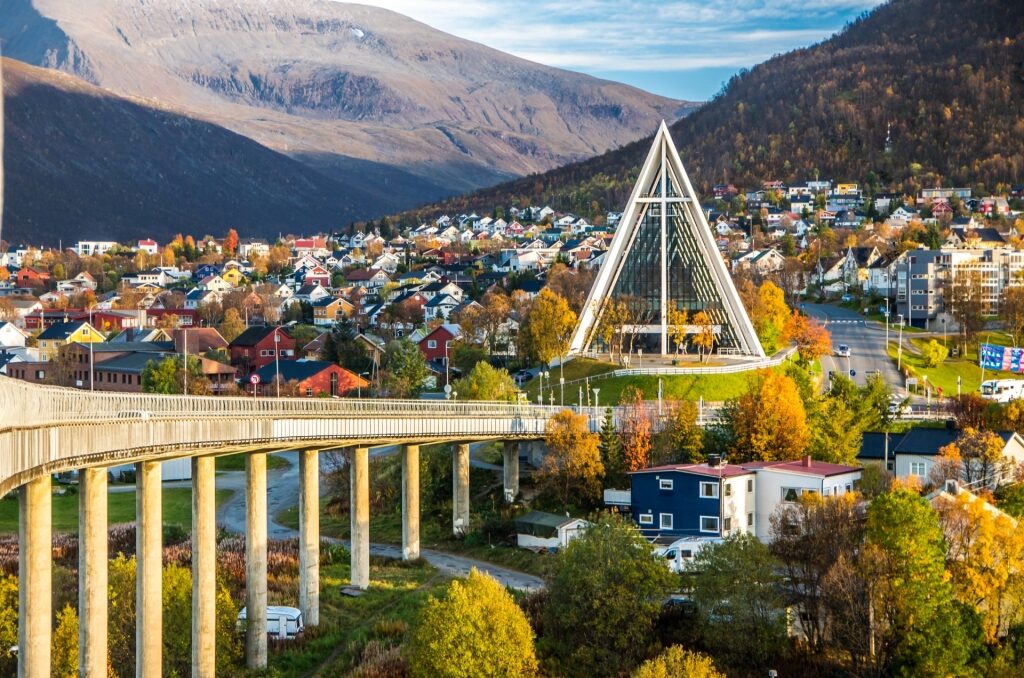
Arctic Cathedral in Tromso, Norway
Tromsøysund Church, often called the “Arctic Cathedral”, has become the town symbol of Tromsø in Norway. Its striking modern design, looking like an iceberg or a Sami tent, symbolizes the Arctic environment.
The church is built of concrete, its interior dominated by a remarkable stained glass mosaic window. The work, by artist Victor Sparre, shows the Return of Christ.
The church was built in 1965 by Norwegian architect Jan Inge Hovig and is his most famous building. Take a guided tour to learn more about its history and the spectacular Northern Lights concerts.
Douro Valley, Portugal
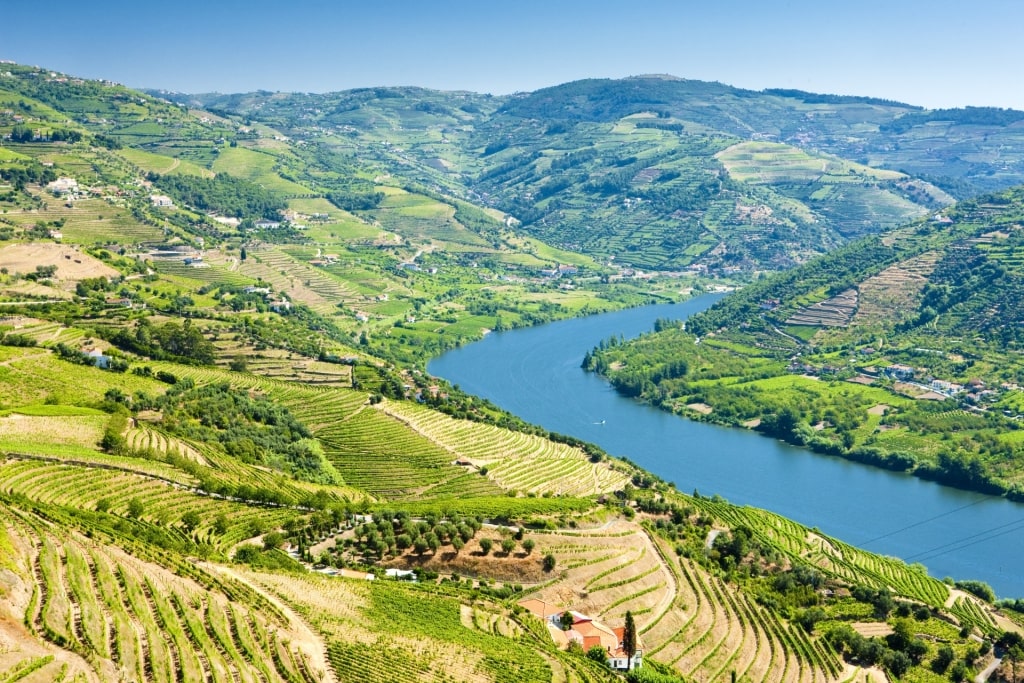
Douro Valley, Portugal
The Douro Valley is a picturesque wine region in northern Portugal. It stretches from just east of Porto to the Portuguese-Spanish border, following the course of the Douro River.
The steep, terraced hillsides, rich with vineyards, form a beautiful landscape. Most famous for its port wine, the region also produces excellent table wines.
The Douro Valley is popular for wine tasting as well as hiking and visiting towns such as Pinhão or Peso da Régua. An essential stop is one or more of the quintas, the traditional wine estates.
Teide National Park, Tenerife, Spain
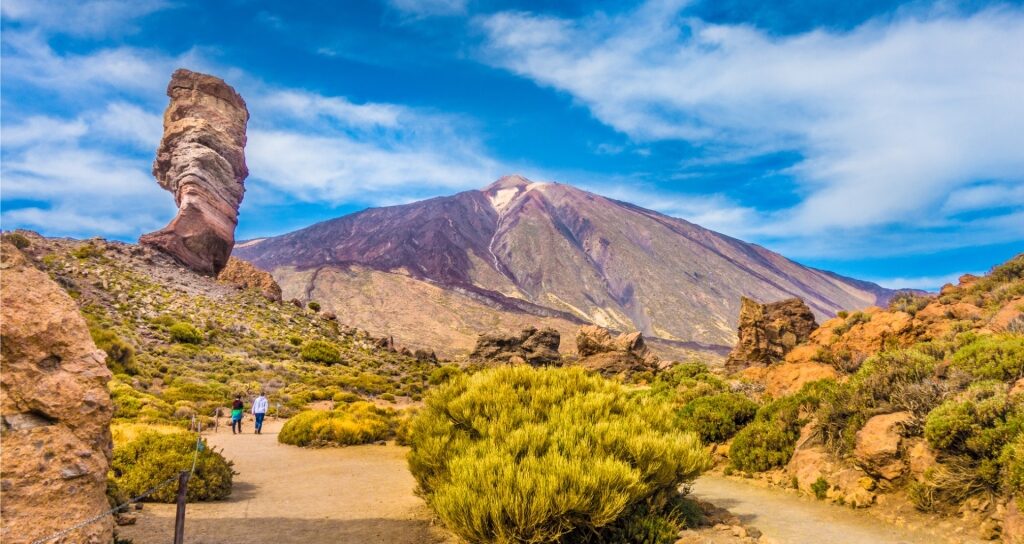
Teide National Park in Tenerife, Spain
Teide National Park is a beautiful natural area on Tenerife, the largest of the Canary Islands. It is centered on Mount Teide, a dormant volcano, and Spain’s highest peak at 12,198 feet.
The park was declared a UNESCO World Heritage Site in 2007 for its geological significance. The volcanic landscape features lava flows, craters, and unique rock formations.
Some of the best things to do in Tenerife include taking a cable car to the top of Mount Teide to enjoy the views, or hiking among the interesting native flora. The visitor center will tell you more about the park’s geology and ecology.
Stonehenge, England, UK
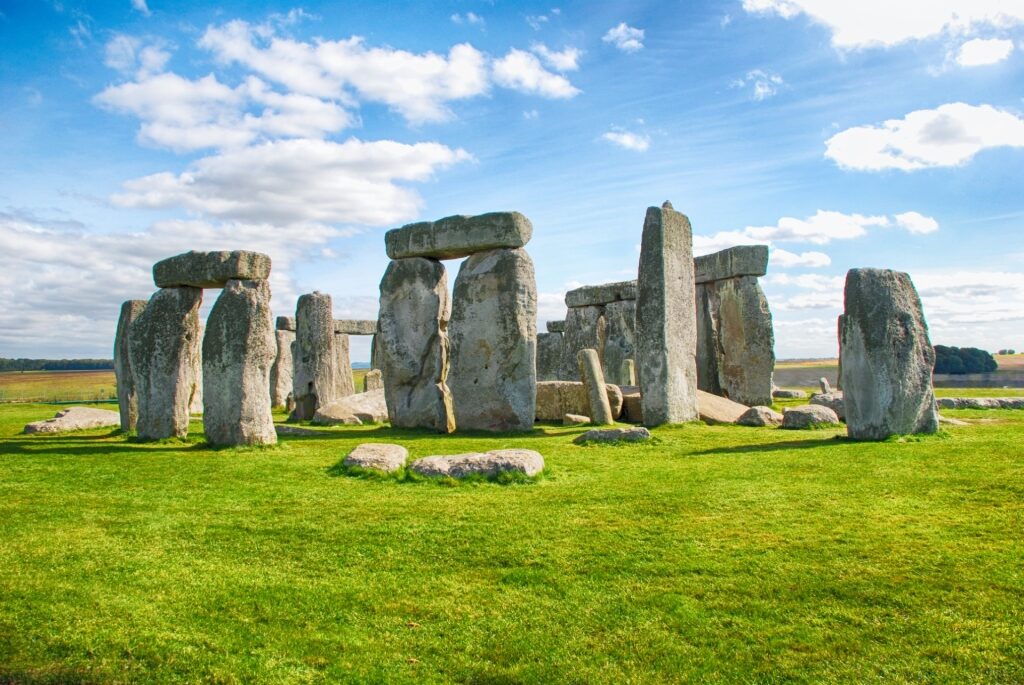
Stonehenge in England, UK
One of the best European attractions and most recognizable ancient sites in the world, Stonehenge is about 4,500 years old. Building this circle of massive stones was an amazing feat for these ancient people.
The average standing stone here weighs 25 tons, with the largest topping out at roughly 30 tons. They were transported 20 miles from Marlborough Downs.
For the most up-to-date theories on how it was done, visit the site exhibition center. It also has more than 250 excavated artifacts and a reconstructed face of a 5,500-year-old man.
Read: Things to Do in & Around Southampton
Rock of Gibraltar, Gibraltar, UK
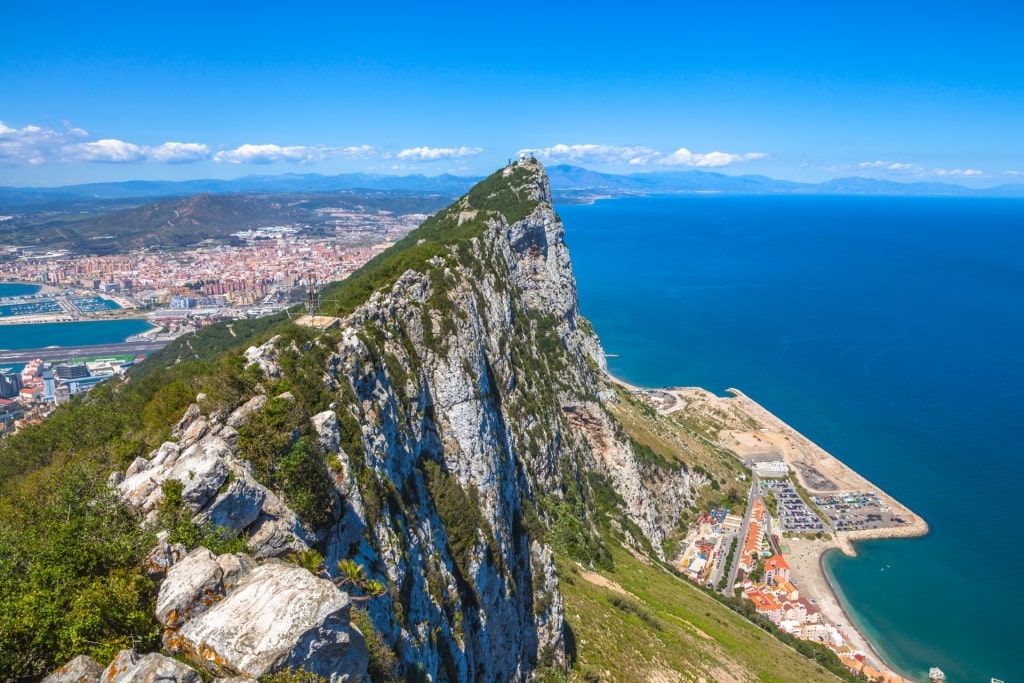
Rock of Gibraltar in Gibraltar, UK
“The Rock” stands in the British Overseas Territory of Gibraltar, guarding the Atlantic entrance to the Mediterranean.
Rising to 1,398 feet above sea level, its strategic importance has left it heavily fortified, with an extensive tunnel network.
You can explore tunnels from The Great Siege of 1779–1783 and World War II. A medieval Moorish Castle offers insights into Gibraltar’s Islamic history.
Much of the Rock is now a protected nature reserve, home to the only wild monkey population in Europe. Taking a cable car ride to the top is one of the best things to do in Gibraltar to take in the panoramic views across to North Africa.
La Seu Cathedral, Palma de Mallorca, Spain
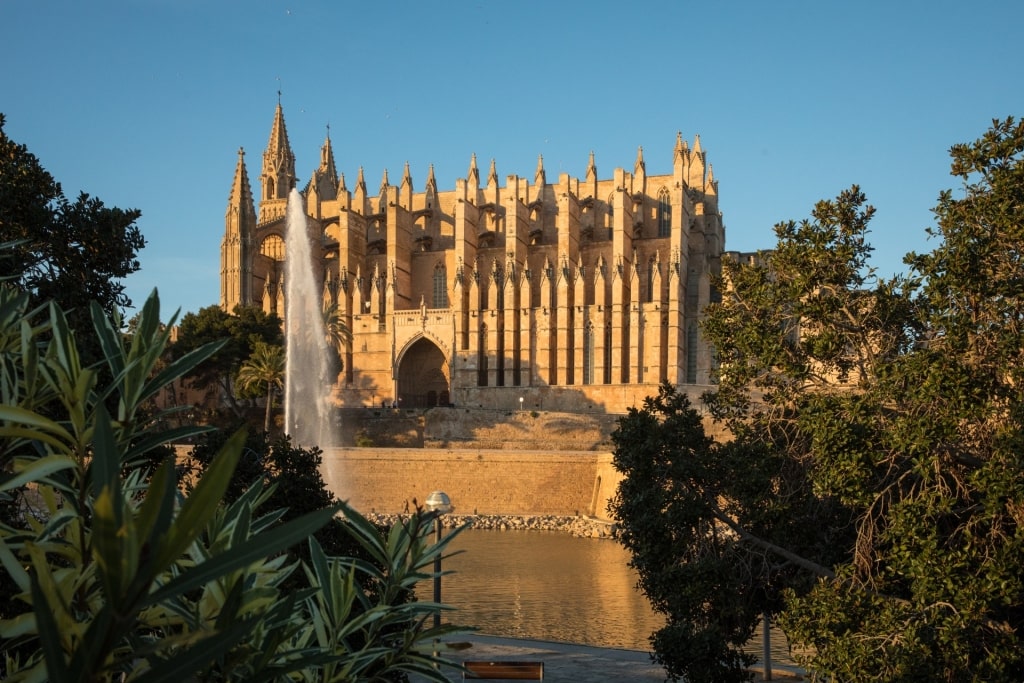
La Seu Cathedral in Palma de Mallorca, Spain
La Seu Cathedral—officially the Cathedral of Santa Maria of Palma—is a landmark overlooking Palma, Mallorca. With building taking place from 1229 to 1601, it is one of Europe’s largest Gothic cathedrals.
The cathedral’s Rose Window is also one of the world’s largest such works in stained glass. Other features include the Royal Chapel, with the tombs of Kings James II and James III of Mallorca.
In the early 20th century, a pupil of Antoni Gaudí designed the large canopy over the main altar. A more contemporary addition is a chapel from 2007 by artist Miquel Barceló.
Read: Best Things to Do in Mallorca
Maspalomas Dunes, Gran Canaria, Canary Islands
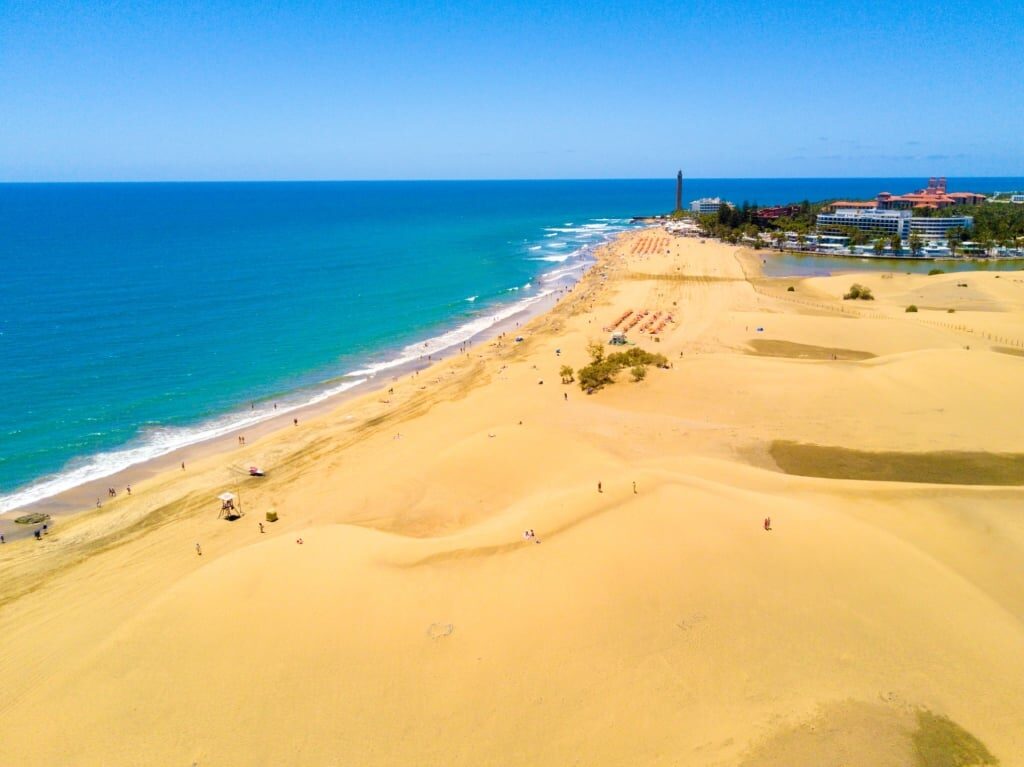
Maspalomas Dunes in Gran Canaria, Canary Islands
The Maspalomas Dunes make up a striking natural feature on the southern tip of Gran Canaria in Spain’s Canary Islands. Covering about 1,000 acres, they were formed from the erosion of coral reefs during the last ice age.
They are now part of a protected nature reserve that also includes a palm grove and a lagoon. La Charca Lagoon is a stop for migratory birds.
The dunes are a popular beach destination in the Canary Islands. You can also ride a camel, visit Maspalomas Lighthouse, or go hiking.
Colosseum, Rome, Italy

Colosseum in Rome, Italy
The Colosseum has become a symbol of Rome in the 2,000 years since it was built. It’s the largest amphitheater ever built in ancient times and its distinctive arched walls remain a remarkable sight.
The arena was originally designed for recreated battles, animal hunts, executions, and mythological dramas. It could seat up to 80,000 spectators and had a moveable canvas sunroof.
To visit is to still be awed by its size and history. This Roman landmark still captures the imagination and the focus of countless works of art, literature, and film.
Pompeii, Italy

Pompeii, Italy
Pompeii is an ancient Roman city near modern Naples. It was famously destroyed by the eruption of Mount Vesuvius in 79 AD.
Buried deep under volcanic ash and pumice, the city was remarkably well preserved and is now one of the best places to visit in Southern Italy. Its excavated buildings and even casts of some of the residents’ bodies provide a truly remarkable snapshot of Roman life.
Landmarks include the Forum, one of the oldest surviving Roman amphitheaters, and the Villa of the Mysteries. Everyday objects have also survived to help bring the past vividly back to life.
Mount Etna, Sicily, Italy
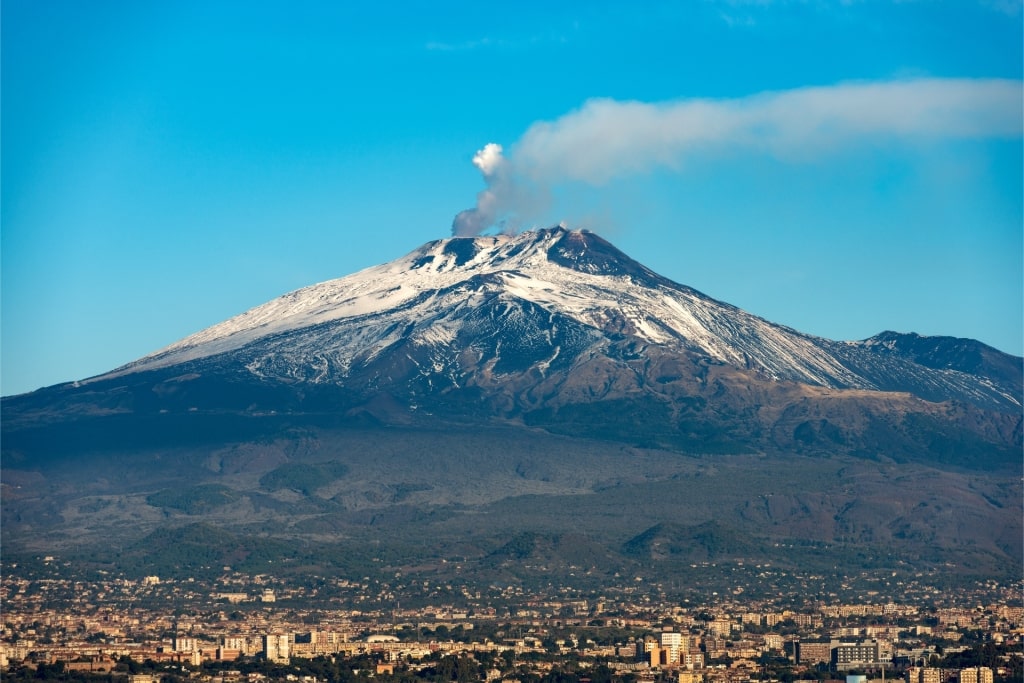
Mount Etna in Sicily, Italy
Mount Etna is an active volcano on the east coast of Sicily and an iconic image of the island. At more than 20,00 feet, it is the tallest active volcano in Europe.
Despite its near-constant state of activity, it’s popular for skiing in winter and hiking in summer. The slopes are home to numerous vineyards producing unique local wines.
You can ride the Funivia dell’Etna cable car up to access higher altitudes. Take in the amazing views or join a guided walk to explore the volcano’s rim.
Blarney Castle, Cork, Ireland
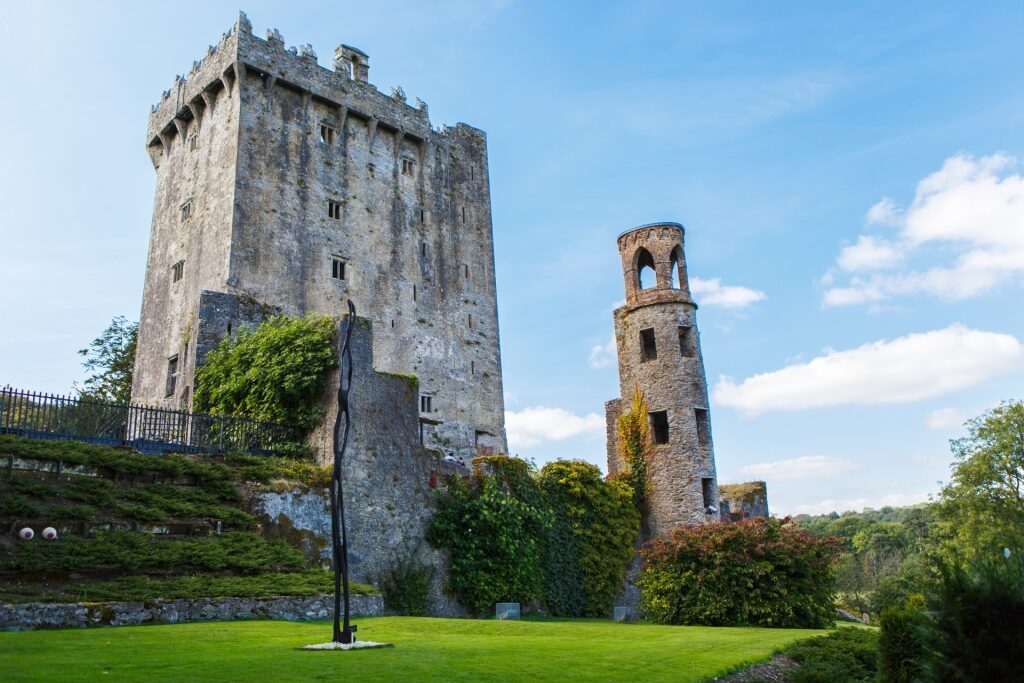
Blarney Castle in Cork, Ireland
Blarney Castle, a medieval Irish stronghold, is famous for its “Blarney Stone’. Kiss this rock on the battlements and according to legend, you will gain “the gift of the gab”, which means eloquence.
The castle dates to around 1446 and stands about five miles from the city of Cork in Ireland. It’s a typical sturdy Irish tower house, with great views, surrounded by lovely gardens.
Besides the Blarney Stone, the castle’s other attractions include spooky dungeons with a network of caves. The Poison Garden, filled with deadly plants, is another essential for thrill seekers.
Read: Things to Do in Cork
Aphrodite’s Rock, Limassol, Cyprus
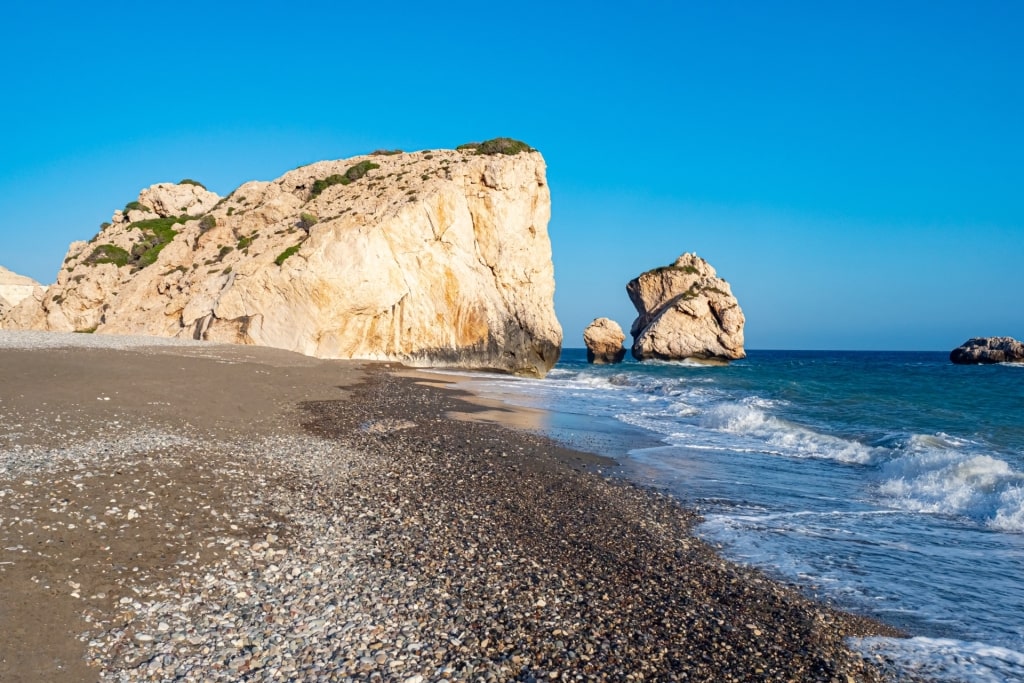
Aphrodite’s Rock in Limassol, Cyprus
Sitting on the coast of southwestern Cyprus, Aphrodite’s Rock has been famous since the time of the ancient Greeks. Their legends claimed it as the birthplace of Aphrodite, the goddess of love and beauty.
Known in Greek as Petra tou Romiou, or Rock of the Greek, there are actually three rocks. Local tradition holds that swimming around them three times will bring you beauty, love, or fertility.
A pebbly beach nearby is the ideal viewpoint from land, but boat tours also visit this popular sight. The lack of sand makes for very clear waters, perfect for swimming or snorkeling.
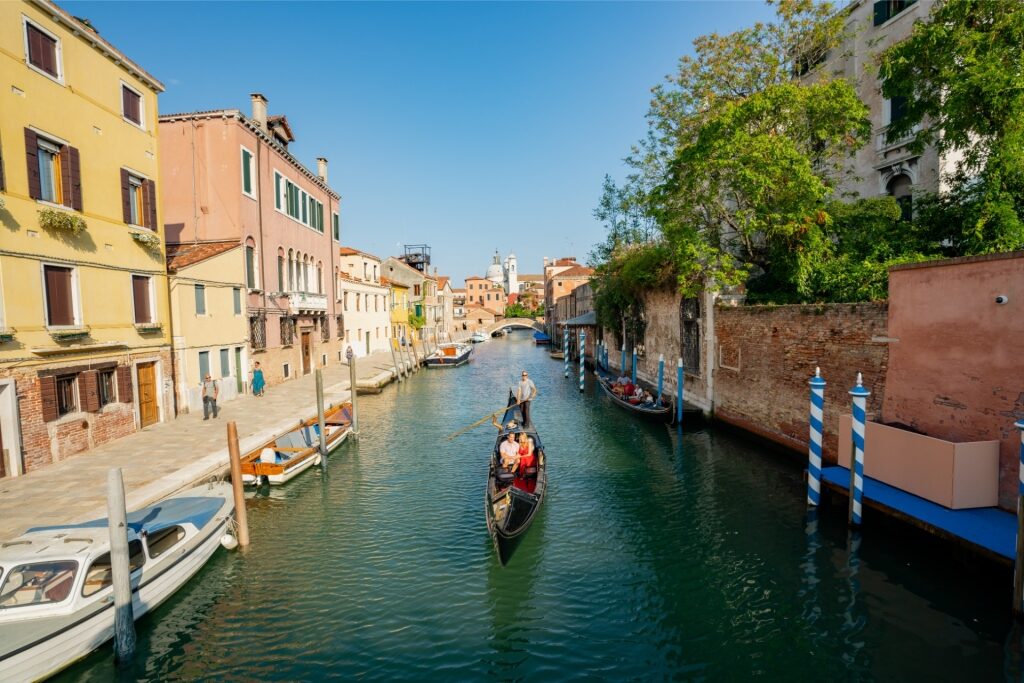
Grand Canal in Venice, Italy
Are you inspired to visit Europe and discover some of its many attractions? Then browse our cruises to Europe and plan your perfect vacation.
